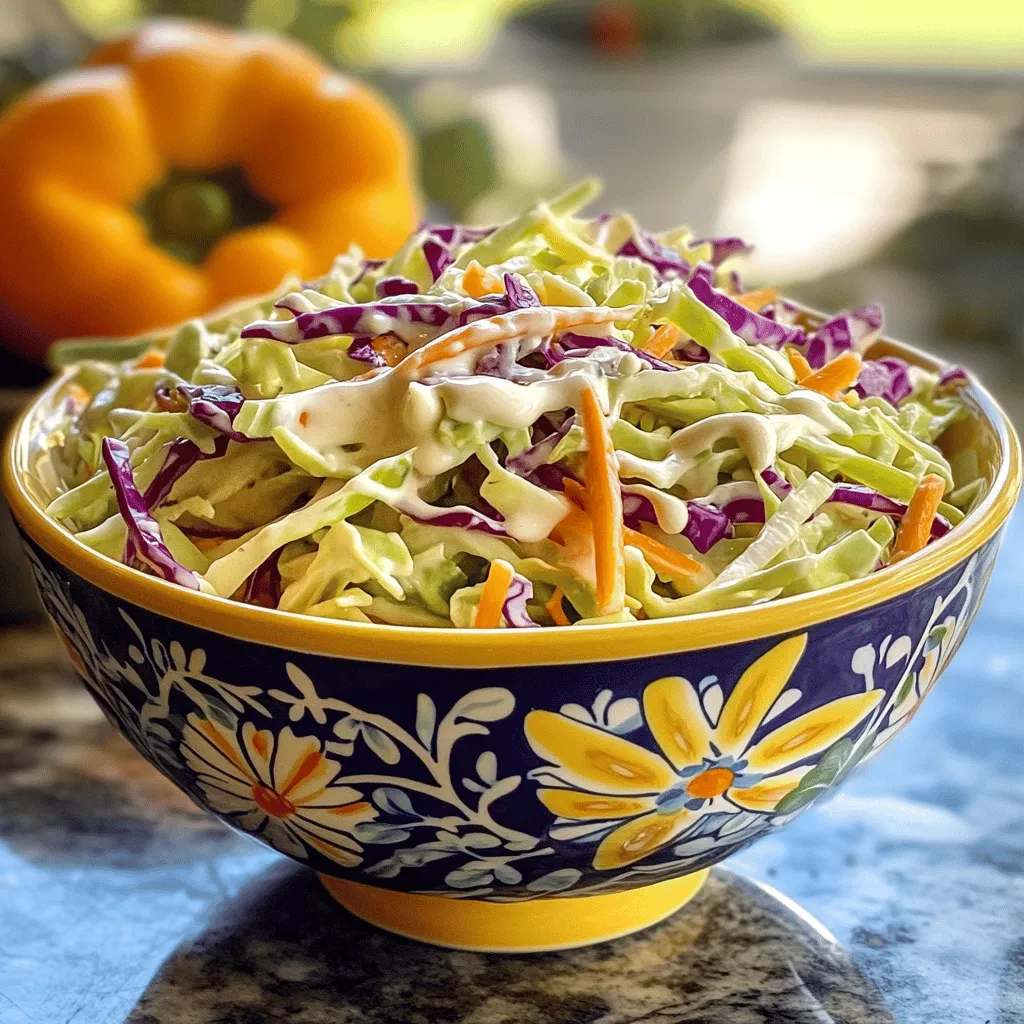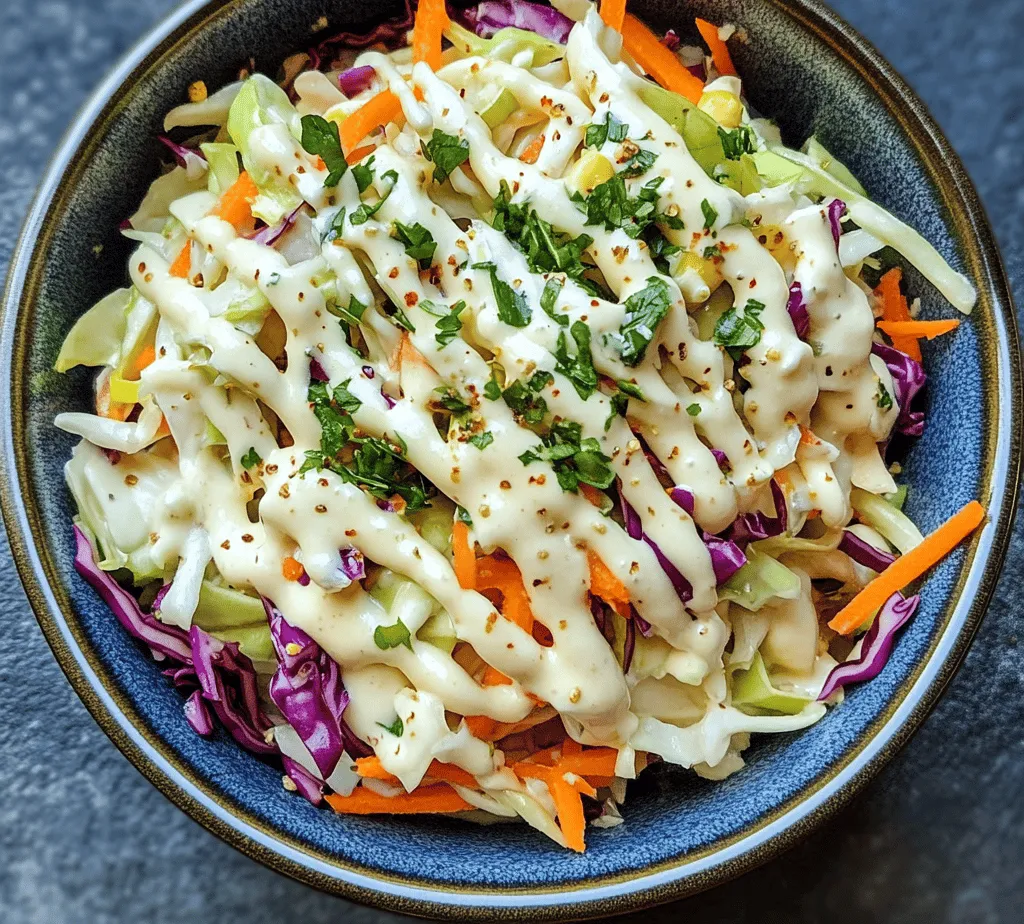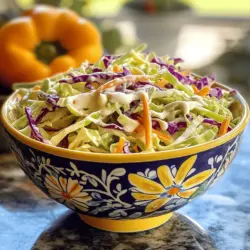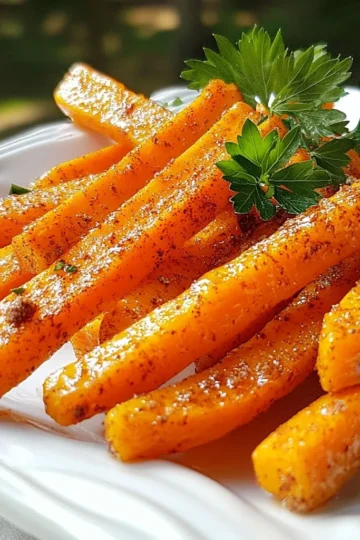Coleslaw is more than just a simple salad; it’s a beloved side dish that brings a delightful crunch and a tangy flavor to a variety of meals. Whether it’s served alongside juicy barbecue ribs at a summer cookout, packed in a picnic basket for a day at the park, or presented as a fresh accompaniment to a hearty family dinner, coleslaw has earned its place in the culinary world. The Crunchy Classic Coleslaw recipe is a perfect representation of this classic dish, combining vibrant vegetables with a creamy dressing that makes it ideal for any occasion.

This recipe is not only straightforward but also celebrates the freshness of its ingredients, making it a go-to choice for those looking to whip up something delicious without a fuss. With just a few basic components, you can create a coleslaw that is both satisfying and nutritious. Let’s delve into the history of coleslaw, its key ingredients, and the simple steps required to prepare this delightful dish.
Understanding Coleslaw
The origins of coleslaw can be traced back to ancient Rome, where a similar dish was made with cabbage, eggs, and vinegar. The term “coleslaw” itself is derived from the Dutch word “koolsla,” which means “cabbage salad.” As it made its way through various cultures and culinary practices, coleslaw evolved into the creamy, tangy salad that we know today, particularly gaining popularity in American cuisine.
In the United States, coleslaw has seen various regional adaptations, from the vinegar-based slaws of the South to mayonnaise-rich versions in the Northeast. Each region adds its unique twist, reflecting local tastes and preferences. This versatility has contributed to coleslaw’s enduring appeal, making it a staple at barbecues, potlucks, and holiday gatherings.
Beyond its delicious taste, coleslaw is also a nutritional powerhouse. The primary ingredients—cabbage and carrots—are packed with vitamins and minerals. Cabbage, for instance, is rich in vitamin K and C, while carrots are a great source of beta-carotene, which converts to vitamin A in the body. These nutrients not only promote good health but also support a strong immune system and healthy vision.
Key Ingredients of Crunchy Classic Coleslaw
To create a delightful Crunchy Classic Coleslaw, several key ingredients come together to form a harmonious balance of flavors and textures. Each component plays a vital role in making this dish a standout side.
Green Cabbage
The backbone of any classic coleslaw is green cabbage. Its crisp texture and mild flavor make it the perfect base for the salad. When sliced into thin strips, green cabbage remains crunchy even after being tossed in the dressing, providing that essential bite that coleslaw lovers crave. Additionally, its high fiber content contributes to digestive health, making it a nutritious choice for salads.
Carrots
Carrots add a natural sweetness to coleslaw, which contrasts beautifully with the tangy dressing. Their vibrant orange color not only enhances the visual appeal of the dish but also signifies their rich nutrient content. Carrots are loaded with antioxidants, particularly beta-carotene, which has been linked to various health benefits, including improved eye health and reduced risk of chronic diseases.
Red Cabbage
Incorporating red cabbage into your coleslaw not only adds a pop of color but also introduces a slightly peppery flavor profile that complements the sweetness of the carrots. Red cabbage is known for its high levels of anthocyanins, powerful antioxidants that can help reduce inflammation and promote heart health. This ingredient not only boosts the dish’s aesthetic but also its nutritional value.
Mayonnaise
Mayonnaise serves as the creamy base of the coleslaw dressing, providing richness and a smooth texture that coats the vegetables beautifully. It helps to marry the flavors together and adds a luxurious mouthfeel. For those looking for a lighter version, alternatives such as Greek yogurt or a vinaigrette can be used, but traditional mayonnaise remains a classic choice.
Apple Cider Vinegar
The tangy flavor of apple cider vinegar is a key component in balancing the richness of the mayonnaise. Beyond its taste, apple cider vinegar offers numerous health benefits, including aiding digestion and potentially improving gut health. Its acidity helps to brighten the overall flavor of the coleslaw, making it more refreshing.
Dijon Mustard
Dijon mustard adds a subtle heat and complexity to the coleslaw dressing. Its sharp flavor enhances the overall taste and provides a slight zing that elevates the dish. The inclusion of mustard also contributes to a more sophisticated flavor profile, making the coleslaw stand out at any gathering.
Sugar
A touch of sugar is essential in balancing the acidity of the vinegar. It brings harmony to the flavors by cutting through the tanginess and enhancing the sweetness of the carrots. The sugar should be used sparingly to ensure that the coleslaw remains fresh and not overly sweet.
Celery Seed
Celery seed is an often-overlooked ingredient that adds a unique flavor to coleslaw. Its slightly earthy and herbal notes enhance the overall taste and provide an aromatic quality. This spice is small but mighty, contributing to the complexity of the dressing without overpowering the other flavors.
Seasoning
Finally, the importance of seasoning with salt and pepper cannot be overstated. These simple ingredients help to bring out the natural flavors of the vegetables and the dressing. A pinch of salt enhances sweetness, while freshly cracked pepper adds a subtle warmth that rounds out the dish.
Step-by-Step Instructions for Making Crunchy Classic Coleslaw
Now that we have explored the wonderful ingredients that make up Crunchy Classic Coleslaw, let’s dive into the preparation process. Making coleslaw at home is straightforward and can be done in a few simple steps.
Preparation of Vegetables
1. Gather Your Ingredients: Start by assembling all the necessary ingredients. You will need green cabbage, red cabbage, carrots, mayonnaise, apple cider vinegar, Dijon mustard, sugar, celery seed, and seasoning.
2. Wash and Dry the Vegetables: Rinse the green cabbage and red cabbage thoroughly under cold water to remove any dirt or impurities. Shake off excess water and pat them dry with a clean kitchen towel.
3. Slice the Cabbage: Remove the outer leaves of the cabbage and cut the heads into quarters. Remove the core from each quarter. Using a sharp knife or a mandoline slicer, thinly slice the green and red cabbage into fine strips. Aim for uniformity to ensure even distribution in the salad.
4. Grate the Carrots: Peel the carrots and grate them using a box grater or a food processor. You can also cut them into matchstick-sized pieces if preferred. The goal is to achieve small, manageable pieces that will mix well with the cabbage.
5. Combine the Vegetables: In a large mixing bowl, combine the sliced green cabbage, red cabbage, and grated carrots. Toss the vegetables together gently to mix them evenly.
With the vegetables prepped and ready to go, you are well on your way to creating a delicious batch of Crunchy Classic Coleslaw. The next steps will involve preparing the dressing and combining it with the vegetables to achieve that perfect, creamy consistency. Stay tuned for the continuation of this recipe, where we will delve deeper into the dressing preparation and final assembly of this delightful dish.

Shredding and Grating for Optimal Texture
To achieve the perfect texture in your Crunchy Classic Coleslaw, properly shredding and grating the cabbage and carrots is essential. Start with a fresh head of green cabbage. Remove any wilted outer leaves and cut the cabbage in half. Place one half cut-side down on a sturdy chopping board and use a sharp knife or mandoline slicer to shred the cabbage into thin strips. Aim for slices that are about ⅛ inch thick. A mandoline can make this task easier and ensures uniformity in size, which is vital for even textures.
For the carrots, peel them first to remove the skin, then use a box grater or a food processor fitted with a grating attachment to produce finely grated carrot. If you prefer a chunkier texture, you can also cut the carrots into julienne strips. The key is to maintain consistency in size between the cabbage and carrots, as this aids in the overall mouthfeel of the coleslaw.
Making the Dressing
The dressing is the heart of any coleslaw, and achieving the right balance of flavors is crucial for a vibrant dish. In a medium-sized mixing bowl, combine 1 cup of mayonnaise, 2 tablespoons of apple cider vinegar, 1 tablespoon of Dijon mustard, and 1 tablespoon of sugar. Whisk these ingredients together until smooth. The mayo provides creaminess while the vinegar adds tanginess, cutting through the richness. The sugar balances the acidity, making the dressing more palatable.
Taste the dressing and adjust the seasonings as needed. A pinch of salt and pepper can elevate the flavors further. If you desire a bit of zing, consider adding a dash of hot sauce or a sprinkle of celery seeds. The goal is to create a dressing that is creamy yet has enough acidity to complement the crunch of the vegetables.
Combining Ingredients
Now that you have your freshly shredded cabbage and grated carrots, it’s time to combine them with the dressing. In a large mixing bowl, add the shredded cabbage and grated carrots. Pour the dressing over the vegetables. With a pair of clean hands or a large spoon, gently toss the vegetables and dressing together until everything is evenly coated. This step is crucial—make sure that the cabbage and carrots are well-mixed, as it ensures each bite is flavorful.
Be cautious not to overmix, as you want to maintain the crunchiness of the vegetables. Once combined, taste the coleslaw again to see if it needs any additional seasoning or dressing. If it feels a bit dry, you can always add more dressing or adjust the flavors to your liking.
The Refrigeration Process
Chilling the coleslaw before serving is an essential step that many home cooks overlook. After combining the vegetables and dressing, cover the bowl with plastic wrap or transfer the coleslaw to an airtight container. Refrigerate for at least 30 minutes, although letting it chill for an hour or more will enhance the flavors even further. During this time, the vegetables will absorb the dressing, and the flavors will meld together beautifully.
This chilling period also allows the cabbage to soften slightly, making it easier on the palate while maintaining that satisfying crunch. Just before serving, give the coleslaw a quick stir to redistribute the dressing, as it may settle during refrigeration.
Serving Suggestions
When it comes time to serve your Crunchy Classic Coleslaw, presentation matters. Consider serving it in a large, shallow bowl to showcase the vibrant colors of the cabbage and carrots. For a touch of elegance, garnish the top with a sprinkle of freshly chopped parsley or a few slices of radish for a pop of color.
Coleslaw is incredibly versatile and can accompany a wide range of dishes. It pairs beautifully with barbecue, fried chicken, or pulled pork sandwiches, providing a refreshing contrast to heavier entrees. For a lighter meal, serve it alongside grilled fish or as a topping for tacos. You can also use it as a filling for wraps or sandwiches, adding a crunchy texture and fresh flavor.
Nutritional Benefits of Crunchy Classic Coleslaw
In addition to being delicious, Crunchy Classic Coleslaw is packed with nutritional benefits that make it a great addition to a balanced diet. The primary ingredients—cabbage and carrots—are both low in calories but high in essential vitamins and minerals.
Vitamins and Minerals
Cabbage is particularly rich in Vitamin C, which is crucial for maintaining a healthy immune system and skin. It also contains Vitamin K, which plays an essential role in blood clotting and bone health. Carrots, on the other hand, are well-known for their high beta-carotene content, which the body converts into Vitamin A, supporting eye health and vision.
Fiber Content
One of the significant advantages of coleslaw is its fiber content. Both cabbage and carrots are excellent sources of dietary fiber, which is essential for digestive health. Fiber helps regulate bowel movements, prevents constipation, and can contribute to a feeling of fullness, aiding in weight management. Including coleslaw in your meal can be a simple way to increase your daily fiber intake.
Low-Calorie Option
For those watching their caloric intake, Crunchy Classic Coleslaw is an ideal side dish. Made primarily from vegetables and a modest amount of dressing, it’s low in calories while still being filling. This makes it a fitting choice for various diets, whether you’re following a low-carb, low-fat, or vegetarian regimen.
Variations to Explore
While the classic coleslaw is delightful, there are numerous ways to customize this recipe to suit your taste preferences. Here are some creative variations to consider:
Adding Fruits
Incorporating fruits into your coleslaw can add a delightful sweetness that balances the tanginess of the dressing. Diced apples or pears lend a crisp texture, while pineapple chunks can introduce a tropical flair. Dried fruits, like raisins or cranberries, provide chewiness and a burst of sweetness that contrasts beautifully with the crunchy vegetables.
Alternative Dressings
For those seeking lighter options, consider swapping out the traditional mayonnaise-based dressing for a yogurt-based dressing or a vinaigrette. Greek yogurt can add creaminess while reducing the calorie count. Alternatively, a simple vinaigrette made with olive oil, vinegar, and a touch of mustard can provide a refreshing and tangy flavor profile.
Seasonal Ingredients
To keep your coleslaw exciting year-round, think about incorporating seasonal vegetables or herbs. In the spring and summer, add radishes or snap peas for added crunch. In the fall, consider shredded Brussels sprouts or roasted squash for a seasonal twist. Fresh herbs like cilantro or dill can also bring a bright flavor that complements the other ingredients.
Conclusion
Crunchy Classic Coleslaw is more than just a simple side dish; it’s a refreshing, nutritious, and versatile accompaniment that can elevate any meal. With its vibrant flavors and satisfying texture, it’s perfect for barbecues, picnics, or weeknight dinners alike. The combination of cabbage and carrots not only provides a delightful crunch but also packs a punch of vitamins, minerals, and fiber, making it a health-conscious choice.
Encourage creativity in the kitchen by experimenting with the recipe, whether through the addition of fruits, alternative dressings, or seasonal ingredients. The joy of home-cooked food lies in customization, and this classic coleslaw recipe offers the perfect foundation for your culinary creativity. So, roll up your sleeves, gather your ingredients, and celebrate the deliciousness of homemade coleslaw!







Leave a Reply